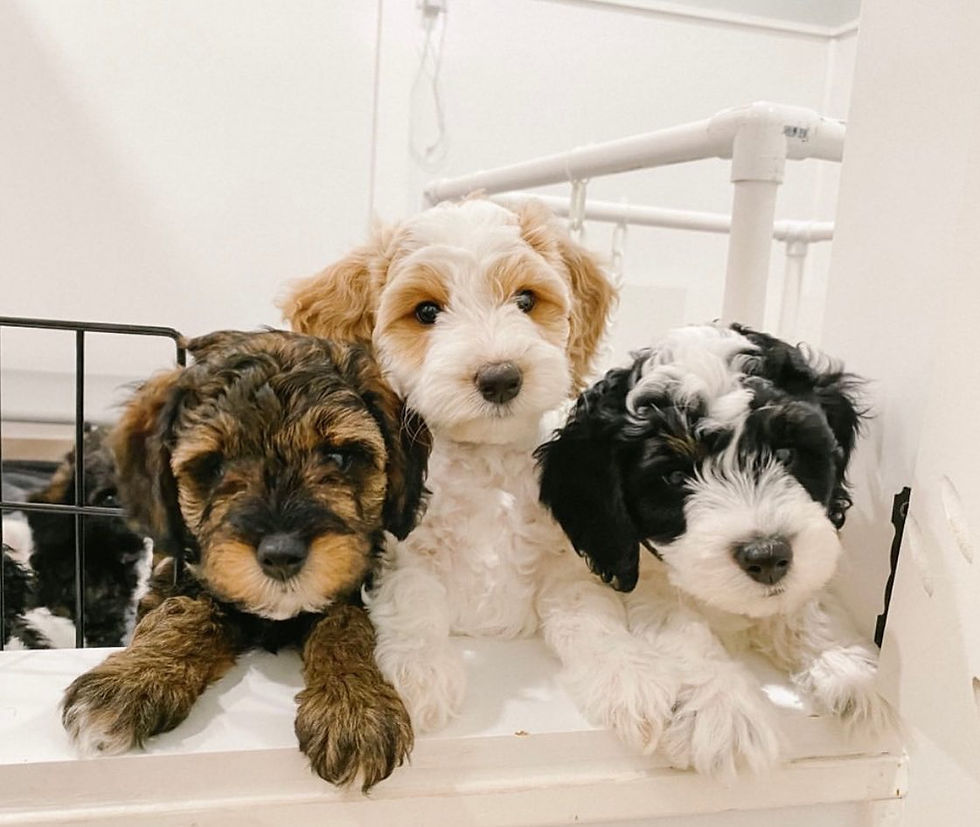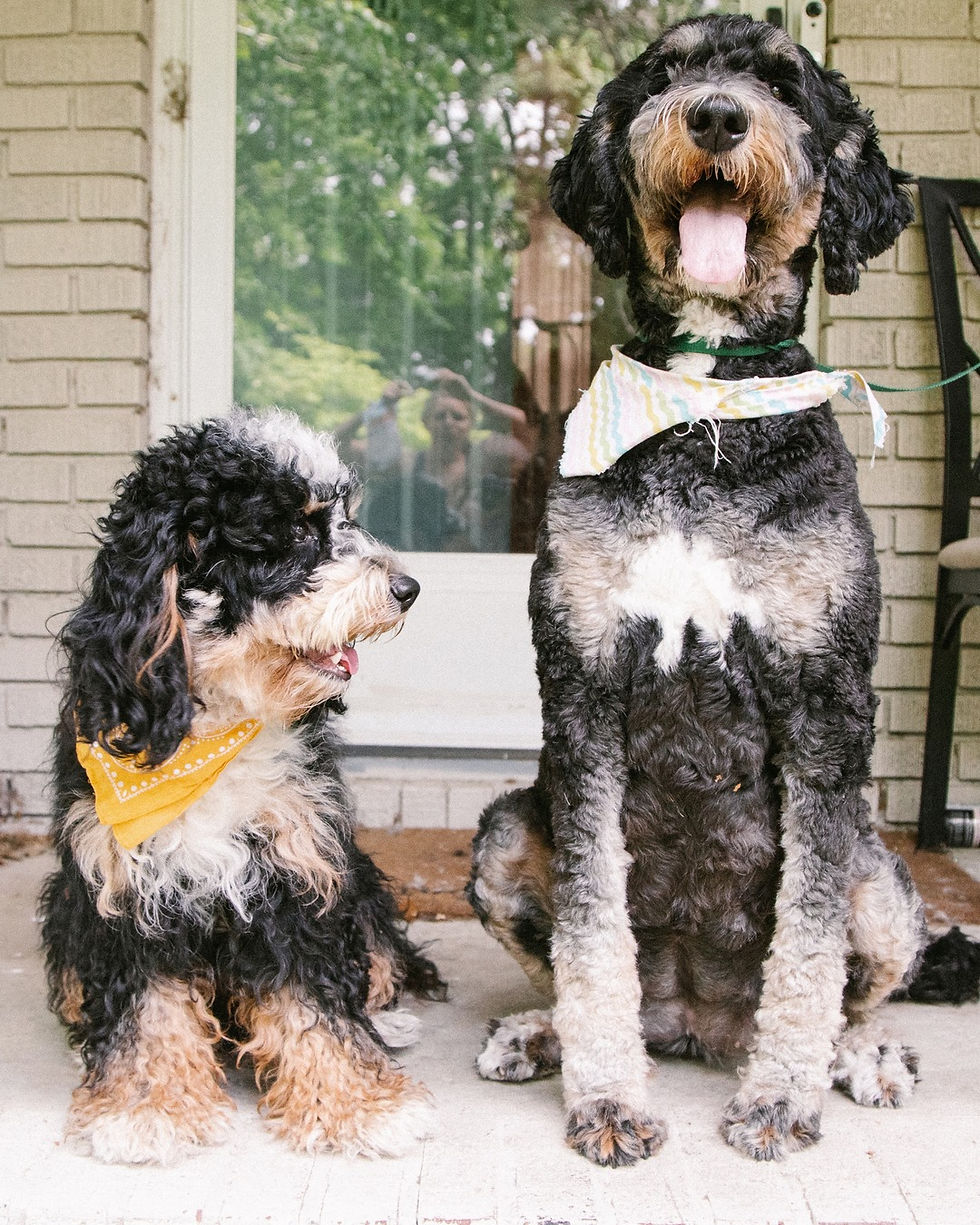Answered: How Early Can You Tell a Puppy’s Temperament?
- JennaLeeDesignerDoodles
- May 10, 2024
- 7 min read
Updated: May 6
Experienced breeders and puppy raisers can tell a lot about a puppy’s temperament from an early age. Here, we will share some of their tips with you when it comes to learning about your pup’s personality as well as provide a basic understanding of the developmental stages of puppies.

Interested in adding a new puppy to your family?
A puppy's temperament develops (in part) very early, during the first two weeks
The first period of puppy development is called the “neonatal period,” and is generally considered to be from birth to two weeks of age. Puppies are born with their eyes and ear sealed so the first two weeks are mostly a frenzy of nursing, snuggling, and sleeping.
Even though a neonatal pup cannot see or hear, they are still learning about the world through smell and touch. We start Puppy Culture when our litters are only three days old — holding them in different positions and offering other tactile stimulation such as tickling toes.
Even at this early age, puppies do react differently to the various touching and holding exercises. For the most part, we do not attach much temperament significance to the puppies’ reactions at this age. A puppy who squirms and squeals when held on his back is more likely to be responding to hunger and being away from his mom rather than signaling that he is a more dominant dog.
Still, there is something to be gained from paying attention to the pups in these early days. A puppy who is consistently calm and quiet during each of the puppy culture exercises or when handled by humans at this young age, often does develop to be a mellow, laidback older puppy.
Nevertheless, as a general rule of thumb, we would not want to make any real claims about a puppy’s personality until they are older. This is why we do not recommend choosing a puppy this young simply based on a photo. Many breeders allow families to select their puppies as soon as they are born.
Color, pattern, and coat type are all apparent from birth, so many families are eager to make their selection based on these factors alone. We caution our readers to make temperament their top priority. That cute little female with the perfect coloring may grow up to be the most energetic out of the litter, which may or may not be the right match for your lifestyle.
You'll learn more about your puppy's temperament in the transition period
Returning to the topic of development, around 2 weeks of age, puppies hit their next big stage in maturity. From 2-4 weeks, they are in the “transition period,” and experience a huge leap in sensual development and early motor skills. It is at around 2 weeks of age that their eyes and ears open. Around three weeks of age, you will notice your puppies begin to walk around with a wobbly gait and even wag their tails and start to play with their siblings.
Again, puppies do act differently from one another during this period, but sometimes it is more based on where they are at developmentally as opposed to true temperamental differences. For example, the puppy who is the most active and always play-biting and jumping on his siblings, may be more energetic and dominant, but it is also possible that he is just a big further ahead developmentally (often the larger puppies in the litter develop slightly faster). He may not stand out in these areas once his siblings catch up to him.
By 4 weeks, all of the puppies in the litter should have the basic skills of walking and playing down pat so their true temperaments begin to slowly emerge. Beginning at 4 weeks, the litter is now in the “socialization period” of puppy development. Around this time, puppies become much more aware of their surroundings.
Previously, they were content to just chew at each other in the whelping box. But now, they are much more interested in the world around them and specifically interested in interaction with humans. The older the puppy is, the more confident we are in making predictions about their temperament. Still, by 4-5 weeks, the basics of their personalities are beginning to shine through.

Early on, puppy temperament can be understood using a Puppy Aptitude Test
While there are certainly things you can learn about each puppy just by observing how they interact with people and their siblings, we find it beneficial to give each puppy a structured temperament test. This helps provide verbiage to explain their unique personalities. Breeders most commonly use the Volhard’ Puppy Aptitude Test.
This test should be performed as close to 8 weeks of age as possible. We test our puppies between 6 and 7 weeks of age. At this age, they should all have developed enough coordination to officially participate in all the parts of the test.
There are many aspects considered on this test such as social attraction (how people-oriented a puppy is), how submissive they are based on their level of comfortability with being gently restrained by a human and even how interested your pup is in fetch/retrieval skills. Even if your breeder does not do a formal temperament test on their litters, they should be able to tell you specifics about each pup by around 6 weeks of age.
Generic descriptions such as “adorable and snuggly” can be indicative that the breeder has not actually spent much time observing and evaluating their puppies. Breeders should know who is the most confident pup(s) in the litter — a puppy who is inquisitive, curious, and the first to greet the human and the last to fall asleep after play time will need a different family than the puppy who is more cautious, startles easily, and likes to nap on laps! Your breeder should be able to describe their puppies’ personalities in great detail.
When it comes to choosing a pup, some breeders may let you meet the litter yourself in person. This can be a fun and telling experience, although we still recommend relying on your breeder as a source of information on the puppies’ personalities as they spend many hours with them on a daily basis and may pick up on details that are not noticeable to you in a short half-hour meet and greet.
Nevertheless, if you as the owner are able to meet and choose your puppy based on temperament yourself, pay attention. Well-socialized pups should be willing to approach a new person (some may do so more excitedly than others), but all should be curious and accepting of human interaction. Puppies that have not been well-socialized will be drastically behind when it comes to various temperament aspects.
If the litter as a whole seems nervous and slow to approach humans, this can be a red flag. It will be much harder to tell specific things about each puppy’s personality as their fear will be the most obvious thing about them—potentially covering up other personality nuances such as dominance versus submission, energy level, etc.
Socialization is an important part developing good temperament

If the litter seems well-socialized and well behaved, then it is time to pay attention to other nuances of each of their personalities. A puppy that quickly runs to you and mouths at your feet or hands, makes eye contact and follows you eagerly will likely be very trainable, but may be “a lot of dog.”
He/she will likely be outgoing, energetic and have a “life of the party” type personality.
This dog would do well in an active home (possibly with kids) and/or an active adult who wants a dog that is eager to participate in training.
How to get a feel for a puppy's personality
A pup that is interested in human interaction but is a little slower to approach may prove to be a more reserved dog. He/she may be more submissive and less excitable in the long run and therefore could be a good fit for an older person or a family that already has another dog.
There are other simple techniques you can employ when meeting a litter of pups. Make a strange sound (such as whistling or jingling your keys) and see which pups respond with curiosity.
Again, this would be a marker of a confident dog who will be outgoing and eager to participate in training. Finally, noting which puppies stay close to you or other humans, and which ones interact with humans for a bit, but then go off by themselves to sniff an interesting object, can indicate their level of independence.
We would like to add that even a formal temperament test is not a perfect crystal ball to your dog’s future personality. It can definitely be predictive of some factors of your pup’s personality, but nurture also has a role to play.
If you take the friendliest, most outgoing pup in a litter, but tie him up in the backyard without access to new people and experiences, he will more than likely become very fearful of new people!
Our goal is to match our families with a puppy that has the right temperament building blocks for their lifestyle, but also educate families on how to build upon this temperament foundation with appropriate training and socialization!
In conclusion, one can learn things about a puppy’s temperament as early as 4-5 weeks, although the older they get the more you can learn and the more reliable a temperament test. By 6-8 weeks, a breeder should be able to tell you many details about your pup’s personality.
And remember, training and socialization have a strong role to play, too! With the right combination of nature and nurture, you will find yourself with a perfect companion for the next 12+ years!
Jenna and the JLDD Team
Recent posts:







Whether you are starting a business, resolving a dispute, purchasing property, or addressing personal matters, professional Legal Services in Saudi Arabia play a vital role in ensuring compliance, protecting your interests, and navigating the legal landscape with confidence. Choosing an experienced legal advisor ensures clarity, peace of mind, and successful legal outcomes in one of the fastest-growing economies in the Middle East.
The UAE continues to grow as a global center for business, tourism, and multicultural living. However, navigating its legal structure without proper guidance can be challenging. This is where Legal Services UAE play an essential role. Whether for individuals or businesses, professional legal support ensures compliance, protects rights, and offers peace of mind when managing legal responsibilities.
In today’s fast-paced business world, onboarding and offboarding are more than just HR checklists — they’re critical processes that shape company culture, employee satisfaction, and overall productivity. How a company welcomes new employees and how it parts ways with them reflects the organization’s values and professionalism.
In today’s competitive market, businesses can’t afford to waste time and resources on manual payroll management. Payroll Outsourcing UAE offers a reliable, secure, and cost-effective way to streamline operations, maintain compliance, and boost overall productivity.
Discover stylish and durable Men’s leather biker jacket designed for comfort, protection, and a bold look. Perfect for riders and fashion lovers, our biker jackets combine premium quality with timeless style.